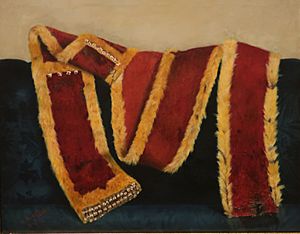Liloa's Kāʻei facts for kids
The Līloa's Kāʻei (pronounced Lee-loh-ah's Kah-ay-ee) is a very special feathered sash. It belonged to Līloa, who was a powerful king on the Big Island of Hawaiʻi. This sash is also known as the Kāʻei Kapu o Liloa, which means "the sacred sash of Līloa." Today, you can see this amazing piece of history at the Bishop Museum in Honolulu.
Contents
What is Līloa's Kāʻei?
This special sash is believed to have been made for King Līloa. He ruled the island of Hawaiʻi from about 1455 to 1485. The kāʻei is not just a piece of clothing. It is a symbol of power and sacredness.
A Gift and a Symbol
King Līloa's eldest son, Hākau, was supposed to take over after him. However, the kāʻei went to his second son, ʻUmi-a-Līloa. ʻUmi's mother was not as high-ranking as Hākau's. The story says Līloa might have given the sash to ʻUmi's mother. This was a sign for them to reunite later. Hākau was not a good ruler. In 1490, ʻUmi took over from him. After this, the kāʻei was not mentioned for many years.
Passing Through Generations
Later, in the 1600s, Līloa's great-great-great-granddaughter, Keākealaniwahine, had the kāʻei. She was a very important chiefess. She used the sash to dress her grandsons, Kalaninuiamamao and Keʻeaumoku. This showed everyone that they were extremely sacred and important chiefs.
The kāʻei then became less known again. But records show it was passed down through many famous Hawaiian leaders. These include Kamehameha the Great, Kamehameha III, Queen Kalama, and King Lunalilo. After King Lunalilo died, his father, Charles Kanaina, had it. Then, King Kalākaua claimed it. He gave it to his sister, Liliʻuokalani. She later gave it to the Bernice P. Bishop Museum. This makes the kāʻei one of the oldest family treasures in Hawaiian history.
Proving Its Age
In 2007, scientists from the University of Kent studied some feathers from the kāʻei. These feathers had fallen off but were saved. They used a method called carbon-dating. This test showed that the feathers were from between 1406 and 1450 A.D. This proved how old and truly special the kāʻei is.
What is the Kāʻei Made Of?
This amazing sash is about 14-foot (4.3 m) long. It is made from the beautiful feathers of Hawaiian birds. Most of the feathers come from the ʻiʻiwi and ʻōʻō birds. There are also some feathers from the mamo bird.
The kāʻei is very delicate. It has a base made of a plant fiber called olonā. A wide red stripe runs down the middle of the sash. Yellow feather patterns cross this red stripe in some places. The edges of the sash are mostly made of mamo feathers. Some parts have yellow feathers from the ʻōʻō bird.
Special Decorations
The kāʻei has some unique decorations. Small human teeth hang from a yellow feather band. At the very bottom, there are rows of human teeth mixed with clusters of small fish teeth. These sections were likely added over time. The human teeth were added to increase the `mana` (spiritual power) of the kāʻei.
The Sacredness of the Kāʻei
The kāʻei was incredibly sacred. This might be why it was sometimes kept hidden. Ancient Hawaiian legends mention only a few kāʻei. They were guarded very closely. It was believed that if someone not allowed to see or touch a kāʻei did so, they would die.
The kāʻei had a very strong `mana`. Even today, personal items are often considered `kapu` (sacred or forbidden) to their owner. For example, in many hālau hula (hula schools), you cannot borrow someone else's instruments or costumes. Wearing such a personal and powerful garment like the kāʻei meant you had a direct connection to the owner's `mana` and family line. It showed you were a true descendant, either by family or spirit. Because `mana` could be lost if not cared for, such a powerful sash needed great respect when used or shown.


